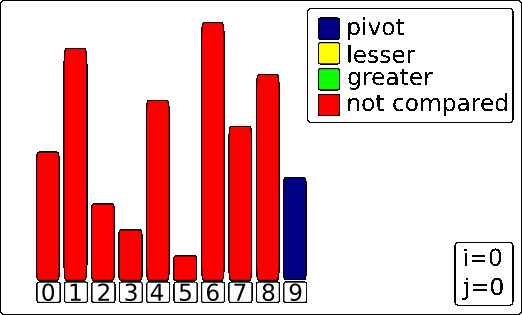21
Quick Sort in Golang

The post Quick Sort in Golang first appeared on Qvault.
Quicksort is an efficient sorting algorithm that’s widely used in production sorting implementations. Like merge sort, quick sort is a divide and conquer algorithm. True to its name, quicksort is one of the fastest sorting algorithms, that said, you need to be careful with the implementation details because if you’re not careful the speed can degrade quickly.
Quicksort actually makes use of two functions, the main
quicksort() function as well as the partition() function. The meat of the algorithm counter-intuitively lives in the partition() function. It’s responsible for finding the pivot and moving everything to the correct side of the pivot.
In Go, the complete code would look like this.
func partition(arr []int, low, high int) ([]int, int) {
pivot := arr[high]
i := low
for j := low; j < high; j++ {
if arr[j] < pivot {
arr[i], arr[j] = arr[j], arr[i]
i++
}
}
arr[i], arr[high] = arr[high], arr[i]
return arr, i
}
<small id="shcb-language-1"><span>Code language:</span> <span>Go</span> <span>(</span><span>go</span><span>)</span></small>The
quickSort() function is really just a wrapper around the partition function, and it handles the recursive nature of the algorithm.
func quickSort(arr []int, low, high int) []int {
if low < high {
var p int
arr, p = partition(arr, low, high)
arr = quickSort(arr, low, p-1)
arr = quickSort(arr, p+1, high)
}
return arr
}`
<small id="shcb-language-2"><span>Code language:</span> <span>Go</span> <span>(</span><span>go</span><span>)</span></small>fmt.Println(quickSortStart([]int{5, 6, 7, 2, 1, 0))
// prints
// [0, 1, 2, 5, 6, 7]`
<small id="shcb-language-3"><span>Code language:</span> <span>Go</span> <span>(</span><span>go</span><span>)</span></small>On average, quicksort has a Big O of
O(n*log(n)). In the worst case, and assuming we don’t take any steps to protect ourselves, it can break down to O(n^2). The partition() function has a single for-loop that ranges from the lowest index to the highest index in the array. By itself, the partition() function is O(n). The overall complexity of quicksort is dependent on how many times partition() is called.In the worst case, the input is already sorted. An already sorted array results in the pivot being the largest or smallest element in the partition each time. When this is the case,
partition() is called a total of n times. In the best case, the pivot is the middle element of each sublist which results in log(n) calls to partition().Quick sort has the following properties.
While the version of quicksort that we implemented is almost always able to perform at speeds of
O(n*log(n)), it’s Big O complexity is still technically O(n^2). We can fix this by altering the algorithm slightly. There are two approaches:O(n) time.O(1) time.The random approach is easy to code, works practically all of the time, and as such is often used. The idea is to quickly shuffle the list before sorting it. The likelihood of shuffling into a sorted list is astronomically unlikely, and is also more unlikely the larger the input.
One of the most popular solutions is to use the “median of three” approach. Three elements (for example: the first, middle, and last elements) of each partition are chosen and the median is found between them. That item is then used as the pivot. This approach has the advantage that it can’t break down to
O(n^2) time because we are guaranteed to never use the worst item in the partition as the pivot. That said, it can still be slow_er_ because a true median isn’t used.Ready to get coding?
Follow and hit me up on Twitter @q_vault if you have any questions or comments. If I’ve made a mistake in the article be sure to let me know so I can get it corrected!
21
